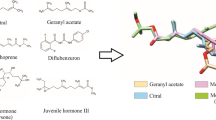Abstract
Dietary ZR-512 and ZR-619 at concentrations of 10 — 1000 ppm induced prolongation of the larval feeding period up to tenfold, increasing larval weight up to double that of untreated larvae.
A comparison study of four juvenoids, using 200 ppm of ZR-512, ZR-515, ZR-619 or ZR-777, showed that ZR-515 elicits the highest larval weight (6.2 mg) and ZR-777 the lowest (3.6 mg). In all cases a pronounced enhancement of larval weight — of 50 — 250% relative to untreated larvae (2.4 mg) — was obtained.Tr. castaneum larvae reared up to their 3rd instars on a diet containing 100 ppm of ZR-512, ZR-515, ZR-619 or ZR-777 and then transferred to a juvenile hormone-free diet, were not affected. The period between 4th instar larva and pupation should therefore be considered as critical for juvenile hormone effect.
The induced prolongation of the larval stage after juvenile hormone treatment was followed by a pronounced enhancement of cuticle phenoloxidase activity, indicating an alteration of the larval biochemical processes.
Although juvenile hormone treatment inhibitsTr. castaneum pupation and emergence, it markedly prolongs larval feeding stage and weight and thus accelerates damage.
Similar content being viewed by others
References
Ascher, K.R.S. and Nemny, N.E. (1974) Toxicity of some juvenile hormone-active compounds forSpodoptera littoralis larvae.Phytoparasitica 2: 41–44.
Bell, W.J. and Barth, R.H. (1970) Quantitative effects of juvenile hormone on reproduction in the cockroachByrsotria fumigata.J. Insect Physiol. 16: 2303–2313.
Benskin, J. and Vinson, S.B. (1973) Factors affecting juvenile hormone analogue activity in the Tobacco budworm.J. econ. Ent. 66: 15–20.
Bhatnagar-Thomas, P.L. (1973) Control of insect pests of stored grains using a juvenile hormone analogue.J. econ. Ent. 66: 277–278.
Bowers, W.S. (1971) Juvenile hormones.in: Jacobson, M. andCrosby, D.G. [Eds.] Naturally Occurring Insecticides. pp. 307–332. Dekker, New York.
Bowers, W.S. and Thompson, M.J. (1963) Juvenile hormone activity: Effect of isoprenoid and straight-chain alcohols on insects.Science, Wash., D.C. 142: 1469–1470.
Bracken, G.K. and Nair, K.K. (1967) Stimulation of yolk deposition in an ichneumonid parasitoid by feeding synthetic juvenile hormone.Nature, Lond. 216: 483–484.
Brunet, P.C.J. (1965) The metabolism of aromatic compounds.in: Goodwin, T.W. [Ed.] Aspects of Insect Biochemistry. pp. 49–77. Academic Press, London.
Chen, D.H., Robbins, W.E. and Monroe, R.E. (1962) The gonadotrophic action of cercopia extracts in allactomized American cockroaches.Experientia 18: 577–578.
Cottrell, C.B. (1964) Insect ecdysis with particular emphasis on cuticular hardening and darkening.Adv. Insect Physiol. 2: 175–218.
Gilbert, L.I. (1964) Physiology of growth and development: Endocrine aspects.in: Rockstein, M. [Ed.] The Physiology of Insecta. Vol. 1, pp. 149–225. Academic Press, New York.
Hackman, R.H. (1964) Chemistry of the insect cuticle.in: Rockstein, M. [Ed.] The Physiology of Insecta. Vol. 3, pp. 471–506. Academic Press, New York.
Ishaaya, I. (1972) Studies of the haemolymph and cuticular phenoloxidase inSpodoptera littoralis larvae.Insect Biochem. 2: 409–419.
Ishaaya, I. and Casida, J.E. (1974) Dietary TH 6040 alters composition and enzyme activity of housefly larval cuticle.Pestic. Biochem. Physiol. 4: 484–490.
Ishaaya, I. and Casida, J.E. (1975) Phenyltin compounds inhibit digestive enzymes ofTribolium confusum larvae.Pestic. Biochem. Physiol. 5: 350–358.
Ishaaya, I. and Navon, A. (1974) Phenoloxidase activity at various stages of development in the Egyptian cotton wormSpodoptera littoralis.Insect Biochem. 4: 67–73.
Jacobson, M., Beroza, M., Bull, D.L., Bullock, H.R., Chamberlain, W.F., McGovern, T.P., Redfern, R.E., Sarmiento, R., Schwarz, M., Sonnet, P.E., Wakabayashi, N., Waters, R.M. and Wright, J.E. (1972) Juvenile hormone activity of a variety of structural types against several insect species.in: Menn, J.J. andBeroza, M. [Eds.] Insect Juvenile Hormones. pp. 249–302. Academic Press, New York.
Karlson, P. and Schweiger, A. (1961) Zum Tyrosinstoffwechsel der Insecten. IV. Das Phenoloxidase-System vonCalliphora und Seine Beeinflussung durch das Hormon Ecdyson.Hoppe-Seyler’s Z. physiol. Chem. 323: 199–210.
Law, J.H., Yuan, C. and Williams, C.M. (1966) Synthesis of a material with high juvenile hormone activity.Proc. natn. Acad. Sci. U.S.A. 55: 576–578.
Minks, A.K. (1967) Biochemical aspects of juvenile hormone action in the adultLocusta migratoria.Arch. Neer. Zool. 17: 175–257.
Pallos, F.M., Menn, J.J., Letchworth, P.E. and Miaullis, J.B. (1971) Synthetic mimics of insect juvenile hormone.Nature, Land. 232: 486–487.
Reddy, G. and Krishnakumaran, A. (1972) Synergistic effect of ecdysterone on morphogenetic activity of juvenile hormone analogues.Life Sci. 11: 781–792.
Riddiford, L.M., Ajami, A.M. and Boake, C. (1975) Effectiveness of insect growth regulators in the control of populations of the German cockroach.J. econ. Ent. 68: 46–48.
Shaaya, E. and Sekeris, C.E. (1965) Ecdysone during insect development. III. Activities of some enzymes of tyrosine metabolism in comparison with ecdysone titer during the development of the blowfly,Calliphora erythrocephala Meig.Gen. comp. Endocrinol. 5: 35–39.
Slama, K., Romanuk, M. andSorm, F. [Eds.] (1974) Insect Hormones and Bioanalogues. Springer, Vienna.
Spielman, A. and Williams, C.M. (1966) Lethal effects of synthetic juvenile hormone on larvae of the yellow fever mosquito,Aedes aegypti.Science, Wash., D.C. 154: 1043–1044.
Staal, G.B. (1975) Insect growth regulators with juvenile hormone activity.A. Rev. Ent. 20: 417–460.
Strong, R.G. and Dickman, J. (1973) Comparative effectiveness of fifteen insect growth regulators against several pests of stored products.J. econ. Ent. 66: 1167–1173.
Thomas, P.J. and Bhatnager-Thomas, P.L. (1968) Use of juvenile hormone analogue as insecticide for pests of stored grains.Nature, Lond. 219: 949.
Williams, C.M. (1967) Third-generation pesticides.Scient. Am. 217: 13–17.
Author information
Authors and Affiliations
Rights and permissions
About this article
Cite this article
Ishaaya, I., Yablonski, S. Induction of prolonged larval feeding stage by juvenile hormone analogues inTribolium Castaneum . Phytoparasitica 4, 9–18 (1976). https://doi.org/10.1007/BF02981074
Received:
Issue Date:
DOI: https://doi.org/10.1007/BF02981074




